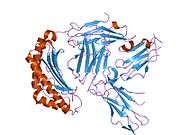Biology:LILRB1
 Generic protein structure example |
Leukocyte immunoglobulin-like receptor subfamily B member 1 is a protein that in humans is encoded by the LILRB1 gene.[1][2]
Function
This gene is a member of the leukocyte immunoglobulin-like receptor (LIR) family, which is found in a gene cluster at chromosomal region 19q13.4. The encoded protein belongs to the subfamily B class of LIR receptors which contain two or four extracellular immunoglobulin domains, a transmembrane domain, and two to four cytoplasmic immunoreceptor tyrosine-based inhibitory motifs (ITIMs). The receptor is expressed on immune cells where it binds to MHC class I molecules on antigen-presenting cells and transduces a negative signal that inhibits stimulation of an immune response. It is thought to control inflammatory responses and cytotoxicity to help focus the immune response and limit autoreactivity. Multiple transcript variants encoding different isoforms have been found for this gene.[3]
See also
References
- ↑ "A novel immunoglobulin superfamily receptor for cellular and viral MHC class I molecules". Immunity 7 (2): 273–82. Aug 1997. doi:10.1016/S1074-7613(00)80529-4. PMID 9285411.
- ↑ "A common inhibitory receptor for major histocompatibility complex class I molecules on human lymphoid and myelomonocytic cells". The Journal of Experimental Medicine 186 (11): 1809–18. Dec 1997. doi:10.1084/jem.186.11.1809. PMID 9382880.
- ↑ "Entrez Gene: LILRB1 leukocyte immunoglobulin-like receptor, subfamily B (with TM and ITIM domains), member 1". https://www.ncbi.nlm.nih.gov/sites/entrez?Db=gene&Cmd=ShowDetailView&TermToSearch=10859.
Further reading
- "Oligo-capping: a simple method to replace the cap structure of eukaryotic mRNAs with oligoribonucleotides". Gene 138 (1–2): 171–4. Jan 1994. doi:10.1016/0378-1119(94)90802-8. PMID 8125298.
- "A novel antigen (H47 Ag) on human lymphocytes involved in T cell activation". Cellular Immunology 152 (2): 371–82. Dec 1993. doi:10.1006/cimm.1993.1298. PMID 8258145.
- "Cloning of novel immunoglobulin superfamily receptors expressed on human myeloid and lymphoid cells: structural evidence for new stimulatory and inhibitory pathways". European Journal of Immunology 27 (3): 660–5. Mar 1997. doi:10.1002/eji.1830270313. PMID 9079806.
- "A new human gene complex encoding the killer cell inhibitory receptors and related monocyte/macrophage receptors". Current Biology 7 (8): 615–8. Aug 1997. doi:10.1016/S0960-9822(06)00263-6. PMID 9259559.
- "Construction and characterization of a full length-enriched and a 5'-end-enriched cDNA library". Gene 200 (1–2): 149–56. Oct 1997. doi:10.1016/S0378-1119(97)00411-3. PMID 9373149.
- "The MHC class I binding proteins LIR-1 and LIR-2 inhibit Fc receptor-mediated signaling in monocytes". European Journal of Immunology 28 (11): 3423–34. Nov 1998. doi:10.1002/(SICI)1521-4141(199811)28:11<3423::AID-IMMU3423>3.0.CO;2-2. PMID 9842885.
- "The ILT2(LIR1) and CD94/NKG2A NK cell receptors respectively recognize HLA-G1 and HLA-E molecules co-expressed on target cells". European Journal of Immunology 29 (1): 277–83. Jan 1999. doi:10.1002/(SICI)1521-4141(199901)29:01<277::AID-IMMU277>3.0.CO;2-4. PMID 9933109.
- "The inhibitory receptor LIR-1 uses a common binding interaction to recognize class I MHC molecules and the viral homolog UL18". Immunity 11 (5): 603–13. Nov 1999. doi:10.1016/S1074-7613(00)80135-1. PMID 10591185.
- "Genomic organization of the human leukocyte immunoglobulin-like receptors within the leukocyte receptor complex on chromosome 19q13.4". Immunogenetics 51 (8–9): 659–69. Jul 2000. doi:10.1007/s002510000183. PMID 10941837.
- "Crystal structure and ligand binding properties of the D1D2 region of the inhibitory receptor LIR-1 (ILT2)". Immunity 13 (5): 727–36. Nov 2000. doi:10.1016/S1074-7613(00)00071-6. PMID 11114384.
- "Functional characterization of HLA-F and binding of HLA-F tetramers to ILT2 and ILT4 receptors". European Journal of Immunology 30 (12): 3552–61. Dec 2000. doi:10.1002/1521-4141(200012)30:12<3552::AID-IMMU3552>3.0.CO;2-L. PMID 11169396.
- "Conserved organization of the ILT/LIR gene family within the polymorphic human leukocyte receptor complex". Immunogenetics 53 (4): 270–8. 2001. doi:10.1007/s002510100332. PMID 11491530.
- "Dual effect of CD85/leukocyte Ig-like receptor-1/Ig-like transcript 2 and CD152 (CTLA-4) on cytokine production by antigen-stimulated human T cells". Journal of Immunology 168 (1): 207–15. Jan 2002. doi:10.4049/jimmunol.168.1.207. PMID 11751964.
- "Mutational analysis of immunoreceptor tyrosine-based inhibition motifs of the Ig-like transcript 2 (CD85j) leukocyte receptor". Journal of Immunology 168 (7): 3351–9. Apr 2002. doi:10.4049/jimmunol.168.7.3351. PMID 11907092.
- "Engagement of ILT2/CD85j in Sézary syndrome cells inhibits their CD3/TCR signaling". Blood 100 (3): 1019–25. Aug 2002. doi:10.1182/blood-2001-12-0303. PMID 12130517.
- "Crystal structure of LIR-2 (ILT4) at 1.8 A: differences from LIR-1 (ILT2) in regions implicated in the binding of the Human Cytomegalovirus class I MHC homolog UL18". BMC Structural Biology 2: 6. Oct 2002. doi:10.1186/1472-6807-2-6. PMID 12390682.
- "Enhanced recognition of human NK receptors after influenza virus infection". Journal of Immunology 171 (2): 915–23. Jul 2003. doi:10.4049/jimmunol.171.2.915. PMID 12847262.
External links
- LILRB1+protein,+human at the US National Library of Medicine Medical Subject Headings (MeSH)
This article incorporates text from the United States National Library of Medicine, which is in the public domain.
 |






